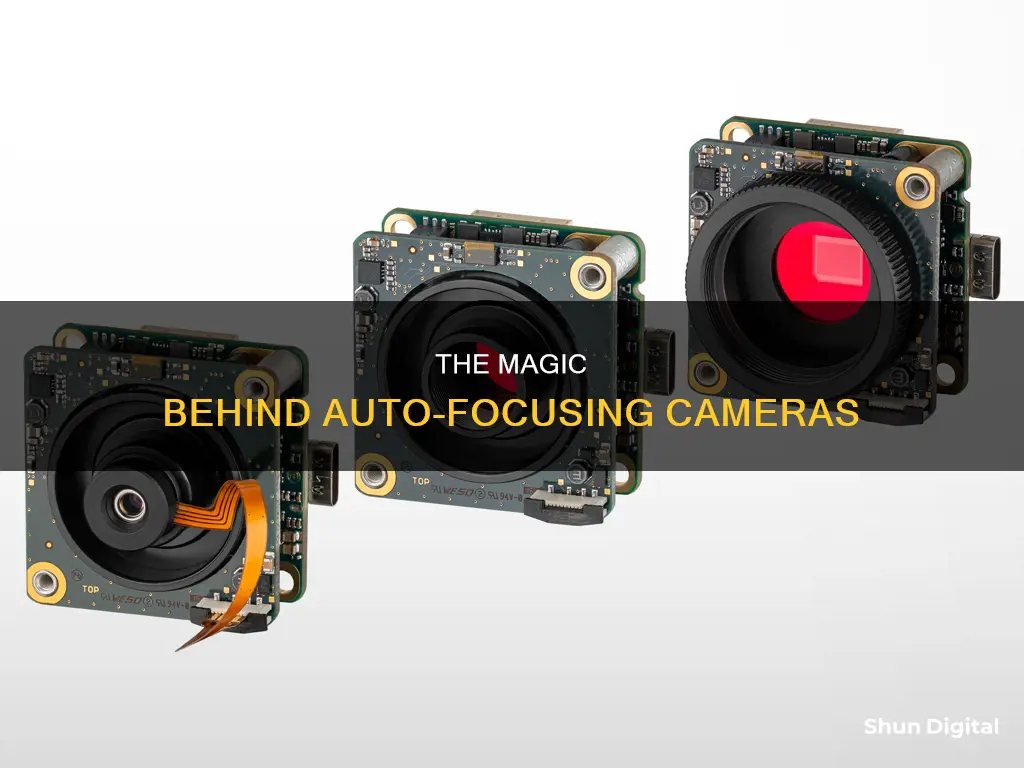
The autofocus (AF) system in a camera is an incredibly useful feature that can be the difference between a sharp photo and a missed opportunity. The autofocus system in a camera intelligently adjusts the camera lens to obtain focus on the subject. The autofocus system relies on sensors to determine the correct focus. There are two main types of autofocus systems: phase detection and contrast detection. Phase detection is very fast and good at tracking moving subjects, while contrast detection is more precise but requires more time to lock focus. The autofocus system can be further classified into active, passive, or hybrid types. Active AF systems measure the distance to the subject independently of the optical system, while passive AF systems perform passive analysis of the image entering the optical system. A hybrid autofocus system combines two or more methods to increase reliability and accuracy.
| Characteristics | Values |
|---|---|
| Type of autofocus | Active, passive or hybrid |
| Autofocus sensors | Passive AF uses contrast sensors within the camera; active AF emits a signal to illuminate or estimate distance to the subject |
| Passive AF types | Phase detection, contrast detection |
| Active AF types | Ultrasonic sound waves, infrared light, time-of-flight principle |
| Passive AF process | 1. AFP makes a small change in the focusing distance. 2. AFP assesses whether and how much focus has improved. 3. AFP sets the lens to a new focusing distance. 4. AFP may repeat steps 2-3 until satisfactory focus has been achieved. |
| Factors affecting autofocus performance | Light level, subject contrast, camera or subject motion |
| Autofocus points | High-end SLR cameras can have 45+ autofocus points; other cameras can have as few as one central AF point |
| Types of autofocus sensors | Cross-type sensors (two-dimensional contrast detection, higher accuracy); vertical line sensors (one-dimensional contrast detection, lower accuracy) |
| AF modes | Continuous, AI Servo, one-shot |
| AF assist beam | A method of active autofocus that uses a visible or infrared beam to help the autofocus sensors detect the subject |

Active vs Passive AF
There are two types of autofocus (AF) systems: Active AF and Passive AF. The Active AF system works by projecting a red beam onto the subject, which then bounces back to the camera, allowing it to calculate the distance between the camera and the subject. Active AF is useful in low-light environments where normal (passive) AF does not function, but it can only be used for stationary, non-moving subjects at close range.
On the other hand, Passive AF works by detecting contrast. It either uses Phase Detection or Contrast Detection (or a combination of both) to focus on the subject. Phase Detection AF is generally faster, making it ideal for tracking fast-moving subjects, while Contrast Detection AF is more reliable in low-light conditions. Some cameras combine the two methods in what is known as Hybrid AF.
Passive AF is the choice of the vast majority of today's cameras. Active AF systems are rarely seen nowadays, but they were around in the early days of autofocus technology.
The Evolution of Victorian Cameras: A Historical Perspective
You may want to see also

Phase Detection
DSLR cameras have a reflex mirror positioned at a 45-degree angle. A small portion of light passes through the main mirror and is reflected by a secondary mirror, which is also tilted at an angle. The light then reaches the autofocus sensor, which redirects it to a group of sensors. The camera then analyses and compares the images from these sensors. If they do not look identical, it instructs the lens to make the necessary adjustments.
Moultrie Camera: Understanding C Battery Requirements
You may want to see also

Contrast Detection
This is also how our brains work when we use unaided manual focus. We look at edges and move the focus ring back and forth until the edge contrast is the hardest.
Fight Camera Speeding Tickets: DC Drivers' Guide
You may want to see also

AF Modes
- Single autofocus mode (AF-S / One-Shot AF): This is the most basic autofocus mode. The camera locks the focus on the subject you want to photograph. If the subject moves, the camera won't adjust the focus. This mode is best for static subjects like portraits, macro photography, and architecture.
- Continuous autofocus mode (AF-C / AI Servo): This mode is ideal for moving subjects. Once you've set the focus, the camera will continue to track the subject, even if they move around within the frame. It's perfect for maintaining focus on constantly moving subjects like eyes for portraits, sports, and wildlife photography.
- Hybrid autofocus mode (AF-A / AI Focus AF): This mode automatically switches between single and continuous autofocus modes, depending on whether the subject is stationary or moving. It's useful when you're unsure whether your subject will be moving or not, such as with wildlife or small children.
Traffic Cameras in Garden Grove: Tickets Still Issued?
You may want to see also

AF Area Modes
- Single-Point AF Area Mode: This mode allows the photographer to select a single focus point, making it ideal for static subjects. The camera will automatically adjust the focus to keep the selected area sharp, even if the photographer moves the camera slightly. This mode is a good choice for landscape and portrait photography.
- Dynamic AF Area Mode: This mode is suitable for capturing moving subjects. The photographer first manually selects a focus point, and if the subject moves, the camera uses this point and the surrounding points to maintain focus. The number of surrounding points used can often be adjusted, making it versatile for different types of movement.
- Group AF Area Mode: This mode is a variation of Single-Point AF, where a small group of focus points is selected instead of just one. It is useful when you want to focus on a specific area or zone within the frame, such as a group of people or animals.
- Auto AF Area Mode: This mode gives the camera full control over which focus points to use. It detects the subject and selects the focus points accordingly, making it a good choice for novice photographers or situations where quick focusing is needed. However, it may not be ideal when more precise control over the focus point is required.
- 3D-Tracking AF Area Mode: This mode is available on some camera models and is designed for tracking moving subjects. The photographer selects an initial focus point, and the camera uses colour recognition to track the subject as it moves across the frame. This mode is useful when the subject's movement is unpredictable.
- Pinpoint AF Area Mode: This mode, available on some cameras, uses Contrast Detection AF to achieve precise focus on a very small portion of the scene. It is typically used for stationary subjects and is only available in AF-S mode.
It is important to note that the availability and behaviour of AF Area Modes may vary between camera brands and models. Photographers should refer to their camera's instruction manual to fully understand the specific AF Area Modes offered by their camera and how to use them effectively.
Campark Cameras: Where Are They Manufactured?
You may want to see also
Frequently asked questions
There are two main types of autofocus systems: phase detection and contrast detection. Phase detection is faster and better at tracking moving subjects, while contrast detection is more precise and commonly used for landscape photography.
Autofocus systems use sensors, a control system, and a motor to focus on a selected point or area. The sensors determine the correct focus, and the control system adjusts the optical system accordingly.
Autofocus is more convenient, faster, and often more accurate than manual focus, especially for tracking moving subjects. It is widely used in sports and wildlife photography. However, manual focus can be useful in low-light conditions or when precise adjustments are needed.







